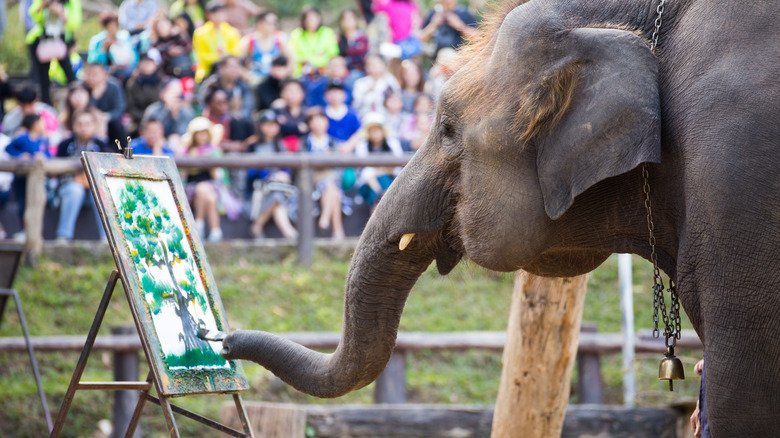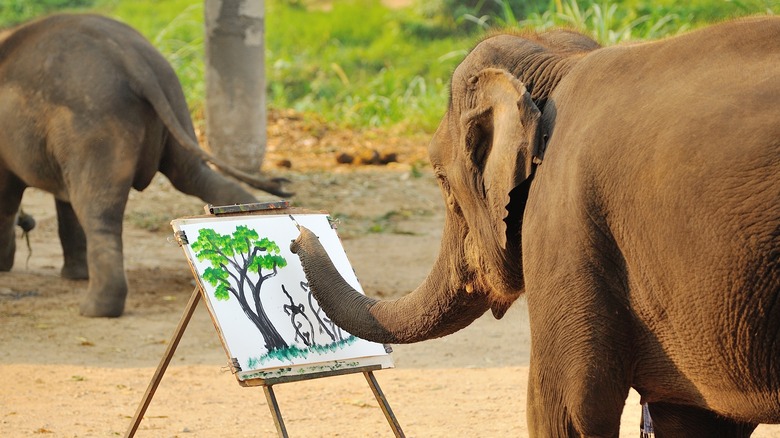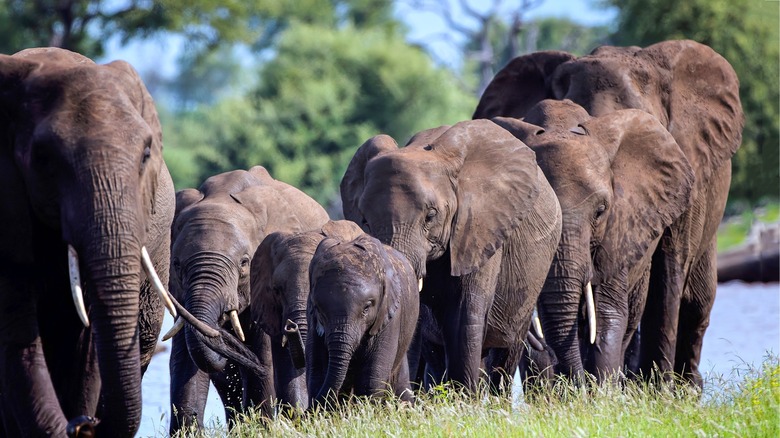Why Elephant Painting May Not Be As Cute As You'd Think
If the internet has taught us anything, it's that humans love when other animals act like us. But before you start fitting miniature cowboy hats on the neighborhood squirrels, it's worth considering if your entertainment could distress the wildlife. Just because an animal can be trained to act like a human, doesn't mean they enjoy it.
It's impressive to see intelligent animals perform human-like behaviors, such as when elephants paint. Certain elephants — such as Suda — have become famous for their talented trunk, raising money for elephant and habitat conservation with each painting sold (via Elephant Art). But an elephant painting shows off their behavioral flexibility, not necessarily their intellect. And it certainly doesn't mean they're enjoying a popular human hobby.
A guiding principle in animal care is the further away an activity or behavior is from what you'd see an animal do in the wild, the less likely it's in their best interest. When scientists looked at how much painting relieved the stress of captive elephants, they found out the activity mostly benefited humans.
Anthropomorphize at your animal's risk
Why do we project human traits onto other animals? A paper authored by renowned behaviorist Dr. Gordon Gallup Jr. in the Journal of Social Issues suggests anthropomorphizing animals is just in our nature. Apparently, the best way for our ancestors to understand members of their social group was to practice seeing the world from other points of view. Why is Claire sitting alone in the corner at the caveman party? Is she going to start throwing rocks? You notice she is holding her old bison-hunting injury. And if you're a regularly functioning human, you can now easily imagine yourself in her position — not feeling like mingling.
When we interact with animals, humans are just doing what comes naturally. We attempt to understand them by imagining how we might feel in their position. And when humans take animals into captivity in zoos, laboratories, or as personal pets, we do our best to provide comfort by identifying with them. In addition to food, water, and a clean enclosure, good animal care includes enrichment opportunities. These are activities we hope will allow the animal to perform natural behaviors and relieve stress.
Pressured pachyderms paint to promote preservation
Keeping in mind that natural behaviors are the most enriching, providing access to human-like activities might not benefit captive animals at all. How do we avoid anthropomorphizing and test if painting is as relaxing to elephants as it is to humans?
In a 2014 study from the scientific journal PeerJ, researchers attempted to measure if the elephants at the Melbourne zoo were less stressed due to their painting enrichment. They did this by examining their behaviors for signs of stress. When animals are stressed out or are in a poor living environment, they behave differently (via Animal Welfare). Because we know so much about what various body movements and postures mean in elephants, it's possible to spot something called stereotyped movements. Captive animals are known to display repetitive movements that don't have any obvious goal, benefit, or function. A stressed elephant might repeatedly bob their head or pace. Measuring these stereotyped behaviors before, during, and after a painting session could tell scientists how relaxing or enjoyable this activity really is.
The researchers found no change in the amount of stereotype behavior in the elephants based on their painting activity. It seemed painting "did not improve the welfare of elephants." Instead, the beneficiaries of this animal activity were the humans. Humans benefited from the "aesthetic appeal of these paintings ... and their subsequent sale."
Step away from that elephant
Zoos and parks around the world attract visitors with their talented painting elephants. While the elephants show little to no signs of distress, the general public isn't trained to recognize stress-like behavior. In an interview with Green Global Travel, activist Lek Chailert urges responsible world travelers not to support elephant parks that sell rides or paintings. She says a number of these parks use abusive training strategies. Chailert describes that some Thailand elephant parks practice phajaan — training of an elephant with torture — until its spirit is broken. Whether you decide to mention this when your cousin posts elephant ride pictures from her recent trip to Thailand is up to you.
No zoo is suggesting that elephants need to paint, but by putting on these displays, they're encouraging public interest through our tendency to anthropomorphize. Good elephant care should first consider their likely physical and behavioral needs (via International Zoo Yearbook). If we consider the best ways we can help any group of animals thrive on this planet, one of the top strategies is to leave them the heck alone.



